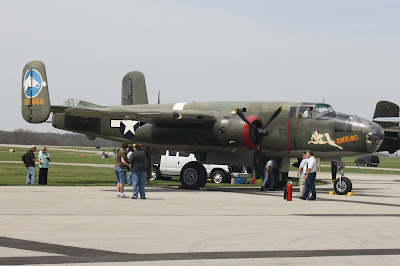It was a sunny, windy day in Urbana, but the 20-30 mph winds didn't seem to bother those big birds. The would rumble down the runway and leap into the air, just as they did in the 40s and 50s. This was the only combat airplane to see action in every front of every theater of WWII. It was also so durable, it saw action well beyond the WWII flights, and wasn't retired until the air force put it out to pasture (air shows by private citizens) in 1960. Another fact that probably isn't too well known is this bomber, in its subsequent editions (up through B-25J model) was also used by our allies around the world.
There was an additional surprise for those gathered along the runways. Two P-51 Mustangs were also at the show, flying escort for the 25s, much like they would have in that war.
One thing I noticed is the structural difference in the various models. Some had glass noses and some didn't. Some had the top turret gunner up front, and some had it in the back, near the tail. I guess it was just which model you were flying.
 |
| I thought this shot of the "flight line" was pretty interesting and probably looked a lot like it would in the War. |
Of course, airplanes weren't the only thing there that day. There were lots of WWII reenactors and lots of equipment. I got a kick out of some of the old vehicles and weapons. I told Pam since I just got a new Jeep, maybe I would buy her a new SUV like the one below.
 |
| It was REALLY windy that day. Pam ran down my hat a couple of times after it blew off my head as I was taking pictures. It also did wonders for her hair. |
I also couldn't pass up the old jeeps. I think CSM Barnett and I used to drive these around in our earlier days.
All in all, it was a really great day. The drive was nice and the weather was just right. What a great way to see these pieces of history. For those of you who were wondering, the flights cost $450 per person, and we thought that was a bit out of our range. I know, I know ... where else are you going to get a chance to ride in a B-25. Maybe some time in the future when I'm richer and a lot more nostalgic.
“There's nothing stronger than the heart of a volunteer.” Gen. Jimmy Doolittle
Hooah




No comments:
Post a Comment